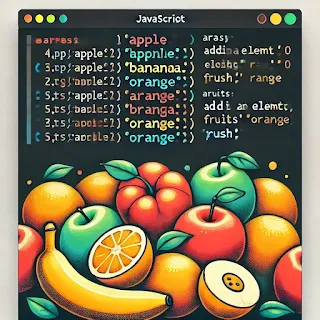JavaScript arrays are fundamental in web development, allowing developers to store multiple values in a single variable. Whether you're dealing with numbers, strings, or objects, JavaScript arrays are versatile tools for data management. Understanding array methods in JavaScript can greatly enhance your ability to manipulate and process data efficiently.
In this guide, we’ll cover JavaScript arrays, JavaScript array methods, and their usage in web development.
What is an Array?
An array is a collection of items stored in a single variable. Each item is assigned a numerical index, starting from 0. Arrays allow you to work with multiple values under a single name, and you can access the items by referring to their index.
Array Declaration
There are two main ways to declare an array:
Using square brackets:
let fruits = ["Apple", "Banana", "Orange"];
Using the
Arrayconstructor:let cars = new Array("Tesla", "BMW", "Audi");
Accessing Array Elements
You can access any element of an array using its index. For example, to get the first fruit from the array fruits:
console.log(fruits[0]); // Output: Apple
Common Array Methods
JavaScript arrays come with built-in methods to perform various operations like adding, removing, or modifying elements. Let's dive into some of the most commonly used array methods.
1. push() – Adding Elements to the End
The push() method adds one or more elements to the end of an array.
let fruits = ["Apple", "Banana"];
fruits.push("Orange");
console.log(fruits); // Output: ["Apple", "Banana", "Orange"]
2. pop() – Removing the Last Element
The pop() method removes the last element of an array and returns it.
let fruits = ["Apple", "Banana", "Orange"];
let removedFruit = fruits.pop();
console.log(fruits); // Output: ["Apple", "Banana"]
console.log(removedFruit); // Output: Orange
3. shift() – Removing the First Element
The shift() method removes the first element of an array and shifts the remaining elements.
let fruits = ["Apple", "Banana", "Orange"];
let shiftedFruit = fruits.shift();
console.log(fruits); // Output: ["Banana", "Orange"]
console.log(shiftedFruit); // Output: Apple
4. unshift() – Adding Elements to the Beginning
The unshift() method adds one or more elements to the beginning of an array.
let fruits = ["Banana", "Orange"];
fruits.unshift("Apple");
console.log(fruits); // Output: ["Apple", "Banana", "Orange"]
5. splice() – Adding/Removing Elements at Any Position
The splice() method can be used to add or remove elements from an array at any position.
To add elements:
let fruits = ["Apple", "Banana"]; fruits.splice(1, 0, "Orange", "Grapes"); console.log(fruits); // Output: ["Apple", "Orange", "Grapes", "Banana"]To remove elements:
let fruits = ["Apple", "Orange", "Banana"]; fruits.splice(1, 1); console.log(fruits); // Output: ["Apple", "Banana"]
6. slice() – Extracting a Portion of an Array
The slice() method returns a shallow copy of a portion of an array into a new array.
let fruits = ["Apple", "Banana", "Orange", "Grapes"];
let slicedFruits = fruits.slice(1, 3);
console.log(slicedFruits); // Output: ["Banana", "Orange"]
7. concat() – Merging Arrays
The concat() method is used to merge two or more arrays.
let arr1 = [1, 2];
let arr2 = [3, 4];
let mergedArray = arr1.concat(arr2);
console.log(mergedArray); // Output: [1, 2, 3, 4]
8. indexOf() – Finding the Index of an Element
The indexOf() method returns the index of the first occurrence of a specified value. If the value is not found, it returns -1.
let fruits = ["Apple", "Banana", "Orange"];
console.log(fruits.indexOf("Banana")); // Output: 1
9. includes() – Checking if an Array Contains an Element
The includes() method checks if an array contains a specified value and returns true or false.
let fruits = ["Apple", "Banana", "Orange"];
console.log(fruits.includes("Banana")); // Output: true
console.log(fruits.includes("Grapes")); // Output: false
10. forEach() – Iterating Over an Array
The forEach() method executes a provided function once for each array element.
let fruits = ["Apple", "Banana", "Orange"];
fruits.forEach(function(item, index) {
console.log(index, item);
});
// Output:
// 0 "Apple"
// 1 "Banana"
// 2 "Orange"
11. map() – Transforming Elements in an Array
The map() method creates a new array by applying a function to each element of the original array.
let numbers = [1, 2, 3];
let doubled = numbers.map(function(num) {
return num * 2;
});
console.log(doubled); // Output: [2, 4, 6]
12. filter() – Filtering Elements Based on a Condition
The filter() method creates a new array with all elements that pass the test implemented by the provided function.
let numbers = [1, 2, 3, 4, 5];
let evenNumbers = numbers.filter(function(num) {
return num % 2 === 0;
});
console.log(evenNumbers); // Output: [2, 4]
13. reduce() – Reducing an Array to a Single Value
The reduce() method executes a reducer function on each element of the array, resulting in a single output value.
let numbers = [1, 2, 3, 4];
let sum = numbers.reduce(function(accumulator, currentValue) {
return accumulator + currentValue;
}, 0);
console.log(sum); // Output: 10
14. find() – Finding the First Matching Element
The find() method returns the value of the first element in the array that satisfies the provided testing function.
let numbers = [1, 2, 3, 4];
let found = numbers.find(function(num) {
return num > 2;
});
console.log(found); // Output: 3
15. sort() – Sorting Elements
The sort() method sorts the elements of an array in place and returns the sorted array.
Conclusion
Arrays and their methods are an integral part of JavaScript, providing powerful tools to handle collections of data. Whether you're adding, removing, or transforming elements, array methods like push(), pop(), map(), and reduce() offer efficient solutions for managing dynamic data.
Mastering arrays and their methods will greatly enhance your ability to manipulate data and build more dynamic and efficient JavaScript applications.
